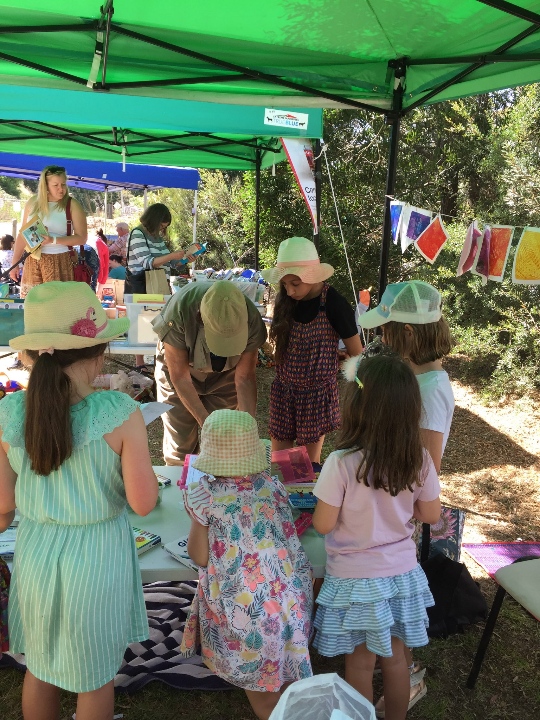Issue 119
Term 4 2021
How to support early literacy with phonemic awareness
Teacher, author and education consultant Judith Barker talks about how library professionals can contribute to students’ early reading and writing success.
When I first read Oh, the Places You’ll Go! to children, it was clear that the repetition and rhyming of the sounds and letters in Dr Seuss’s whimsical story seemed to fully resonate with them. I was at an international school in Italy, and the children would separate the individual sounds (s-a-t), recognise the syllables in spoken words (ha-ppy) and manipulate the letters to make different words (look, book). However, trying to master the many vagaries of English spelling became much more of a challenge for them. With so many peculiarities in the English language, the mind boggles! There are 44 sounds and hundreds of ways to spell them, but how do you explain that the words rough, cough and plough each sound very different?
While researching a masters degree in phonological awareness, I began to use visual sounds in stories by writing fun and lyrical phoneme-themed (sound) stories and highlighting the graphemes (letters). (The Oo in Uluru is one of these.) These stories helped children to develop a wholistic sense of the orthographic (writing) system and the different spelling patterns – in an enjoyable and meaningful way. This propelled me to further investigate the science of reading by studying the multiplicities involved in supporting phonemic awareness and teaching phonics to young readers and students with special needs.
Some terminology
Library professionals of course play an important role in the development of literacy and enjoyment of reading. Maybe you are unaware of some important terminology and major new resources now available in this area. Teachers at your school may already know or use these terms and resources, so being familiar with these will help you to discuss literacy with them.
Just a note, though: terminology can vary in schools, the media and the community, but those below are based on well-established explanations on major government education websites. You will find them in all of the items in the Resources section below.hem.
Phonological awareness
Phonological awareness is an umbrella term for critical early skills in literacy development. It relates only to oral language, to the ability to hear and discriminate sounds in spoken words. It is the first building block for learning to read. Students who have this awareness of the sounds in spoken words are more likely to have later success in reading and spelling, as they will already have an understanding of the ways that language can be broken down.
Phonics
Phonics is about letter–sound knowledge, and it depends on the learner’s ability to hear the separate sounds in words. It relates to the point where letters (graphemes) of the alphabet are introduced to children. You can see a good description of it on the Literacy Hub's Working with phonics' page. You may have heard the phonics term ‘analytic phonics’. Evidence for Learning has a references appendix that discusses phonics. It explains that this is often known as the ‘whole word’ approach. It is based on the learner having some pre-existing phonological awareness, and begins with the whole word, with smaller parts of it sounded out.
More recently you may have seen the term ‘synthetic phonics’ or 'systematic synthetic phonics' increasingly used. Also based on the learner having some pre-existing phonological awareness, it focuses on a set progression that builds on the development of phonemic awareness as a key skill.
Breaking the code of written language
So, before children learn to read print, they need to become aware of how the sounds in words work. They must understand that words are made up of individual speech sounds, or phonemes. Children then learn to blend these sounds together to make words.
The development of this phonological skill is essential in ‘breaking the code’ of the written language.
Terms used here often overlap in the classroom. For more detailed phonics information and resources for libraries and schools see Resources below.
Encouraging students' confidence and success in reading
Both phonemic awareness and phonics are taught on a continuum (in a progressive way) and are essential tools for early reading and writing success. Once children have learned how to ‘break the code’, they need opportunities to apply their phonemic awareness and knowledge of phonics by reading and to experience success in the early stages.
Children all learn how to read at different stages on the continuum – and some require individual support. But no matter what level the child is at, there are a number of important ways to encourage confident readers.

Supporting Frequency of reading
Supporting frequency of reading We all know one of the most important ones: that reading practice and repetition strengthen fluency, as they help children develop word and sound recognition. To achieve confidence, children need to practise their skills frequently to internalise the sounds and orthographic system.
Frequent opportunities for children to apply what they are learning about letters and sounds to the reading of words, sentences and stories can help to consolidate the teaching and learning in the classroom, in the library and at home. Creating these opportunities for children to obtain meaning from print improves their chances of reading success.
Teaching sounds along with the letters during reading can help to reinforce how the sounds are related to reading and writing. Such integration of phonics and phonemic awareness into reading children’s books enhances each child’s experience, especially the experience of struggling readers.
Using enjoyable children's books
Children’s story books are one of the best and most enjoyable tools for promoting phonemic awareness. Reading books with rhymes is always helpful, as these help children to learn how to sound out the words and recognise rhyming patterns. While huge numbers of children have fallen in love with the wacky characters from classic Dr Seuss books such as Hop on Pop, The Lorax and Green Eggs and Ham, Meredith Costain’s Doodledum Dancing (illustrated by Pamela Allen) is another great hit with children. You may know of many more.
Milestones for early reading success
A child’s skill in phonics and phonemic awareness is critical later for measuring their reading and writing success.
These two resources will help you and the whole school community with this:
- The Literacy Hub is a new Australian Government resource for School leaders, teachers, and families.
- The Australian Curriculum’s National Literacy Learning Progression. You can see all of its elements (and expected outcomes for each of them) there.
Some strategies for supporting beginning readers
Here are some useful ways you and others in the school community can support students.
- Use context and pictures to monitor sound, letter and word recognition.
- Sound out letters, identify high-frequency words (common, or ‘sight’ words) in stories.
- Use repetition often to consolidate the teaching and learning of sounds and letters.
- Provide opportunities for reading a variety of texts, to obtain meaning from sounds, letters and words.
- Support the teaching of spelling by helping children to understand that sounds create different letter combinations.
- Help children to sound out unfamiliar words and encourage self-correction.
- Support children to make predictions, identify the main idea in paragraphs and practise summarising.
We want all children to be happy, confident readers and writers.
See the resource list below and enjoy working with teachers at your school to help the students who come to your library to find books that will support their literacy and love of reading.
Resources for library professionals and teachers
- Australian Curriculum: Australian National Literacy Learning Progression.
- Australian Government Department of Education and Training (funder) and Education Services Australia (manager). (2021) The Literacy Hub.
- AUSPELD Recommended literacy apps for primary school children.
- AUSPELD supports students and adults throughout Australia struggling with both learning difficulties and specific learning disorders. A directory of selected apps is available in the target areas of phonological awareness, phonics, reading, writing and vocabulary/grammar. SCIS No. 5364143 (Reviewed by Nigel Paull in Connections 118)
- Evidence for Learning
- Evidence for learning: technical appendix
- Five from Five
- New South Wales Government Department of Education (June 2020): Effective reading in the early years of school: Phonological awareness.
- Victorian Government Department of Education and Training (July 2021) Literacy teaching kit: Phonics.
